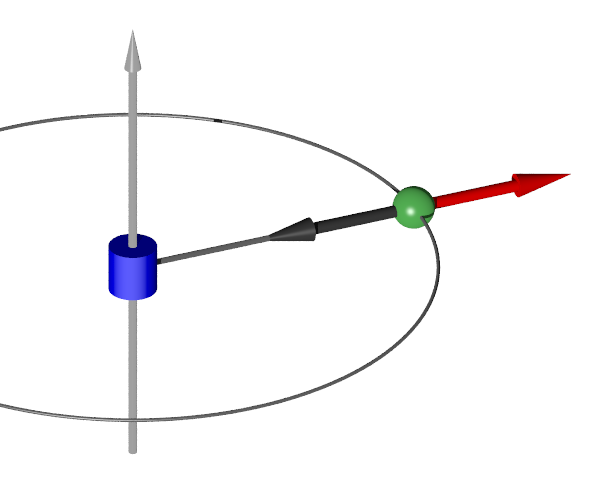
I've heard from a number of flat-earthers that the spinning globe doesn't make sense because the objects would fly off of it. Just like a merry-go-round, the spinning creates a centrifugal force. They usually follow that up with irreverent numbers like the fact that the Earth has a rotational speed of around 1000 mph. But they fail to understand that linear distance traveled is not related to centrifugal force. Example video below.
The reason why we do not fly off the Earth is because the Earth rotates very slow. The mathematical formula we use to calculate the G(gravitational) forces placed on an object is:
G-Force = 0.0000284 x Rotor Radius(inches) x (RPM)²
For the globe, the formula should be configured as:
G-Force = 0.0000284 x 250,000,000" x .0006944^2
Based on these numbers, the G-force exerted on any given object is 0.003435 G. That's 3.4 tenths of one percent of a Gravitational Unit. This force would be greatest at the equator. In the Mid-West USA (where I reside) the G-Force exerted on me would be about half, so .0017 G.
For those who don't understand the numbers well, a G-Force is the standard unit unit of measure of gravity. In other words, how much force gravity is exerting on us. Gravity would be just 1 G since it's the origin of the unit, just like 1 HP would be 1 horse. So, the gravitational pull exerted on us is 1 G and the centrifugal force being exerted on us by the spinning of the globe is .0034 G. That is a minuscule amount of force.
But what about the youtube videos of people spinning wet balls?
The flat Earth movement basically survives via youtube demonstrations and bad conclusions. One bad experiment that keeps popping up is people spinning balls and showing water or other things flying off of the ball. We can pretty easily explain this with logic and more importantly with math.
Let us start with logic. One of the reasons that water is pulled (yes pulled) off the ball is because the ball does not have enough mass to overcome the gravitational pull from Earth. In short, gravity is helping to pull the water off the ball which is why most of the water runs off before it even starts spinning. The lack of water sticking is also due to the fact that the balls are relatively smooth and the water cannot "grab" onto anything.
About the math though..... Most of these experiments show a basketball (or another sized ball) spinning about 1-5 RPS. So how much centrifugal force is being applied to the water? Based on our formula from before, and a nominal RPS of 2, it's a much higher G-Force than the Earth's. Again, using a basketball for a reference we will calculate the force.
G-Force = 0.0000284 x Rotor Radius(inches) x (RPM)² G-Force = .0000284 x 4.77" x 120^2 G-Force = 0.767 G
Based on the math, a basketball spinning about twice per second exerts roughly 225 times MORE gravitational force outward than the spinning of the earth. This should also be placed in the perspective that a basketball has no gravitational force to pull the water back into it. In fact, we can calculate this force (or lack-there-of).
For a basketball with a mass of .626kg and a single molecule of water, the force of gravity that the ball exerts on the water molecule, from .1mm away, is 0.0000750834 G. Whereas, the centrifugal force being exerted in the opposite direction (away from the ball), is .767 G. See the problem with the spinning ball demonstration? The ball has basically no gravitational force and a very high centrifugal force.
How fast does the earth need to spin to overcome gravity?
In order to overcome the gravitational pull of the Earth, it would need to spin much faster. But how much faster? About .011867 RPM, or .71 RPH. That means the Earth would have to do a full rotation every hour and 15 minutes. That would be about 19 times in a 24 hour period. Once again this is all based on easy to prove math that can be tested and verified. We just need to re-apply our previous formula to find RPM with the known variables. Example below.
RPM = √(G-Force / (0.0000284 x Rotor Radius)) RPM = √(1G / (0.0000284 x 250,000,000))
RPM = .011867 if we assume a G force of 1 unit which is equal to the force of gravity. That is how fast the earth must spin to overcome gravity. But it spins at .0006944 RPM which is nowhere close. The rate would have to increase 18 fold.
Last, we should briefly address the equatorial bulge around the equator, which seems to perplex flat-earthers. What most people leave out is that most of the bulge was formed while the earth was mostly molten. Since the solidification of the Earth's crust, the equatorial bulge has actually been decreasing. Not only that but the bulge is calculated to only 14 miles. The earth is about 7919 miles in diameter which means the bulge equates to about 0017% deviation from a perfectly spherical Earth. Imagine again the basketball globe, being squeezed on the ground so that it's 0017% wider than it is tall. That equates to just 1mm wider than it is tall. That is not even close to being visible to the baked eye. That is proportionally how small the Earth's equatorial bulge is. That is why it's not seen in pictures. It's just too small of a bulge.
Comments